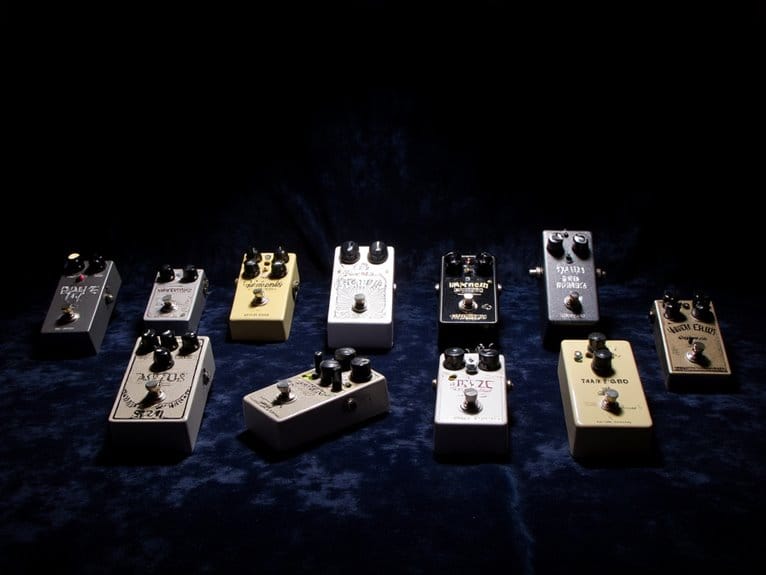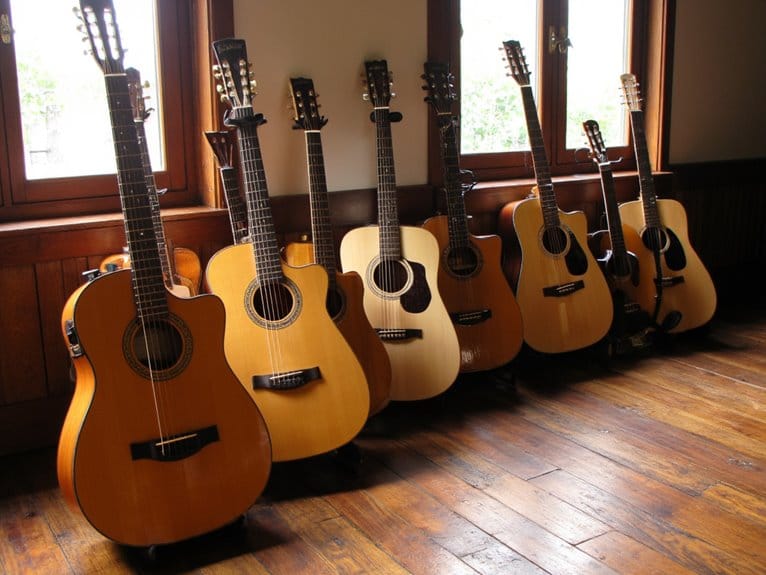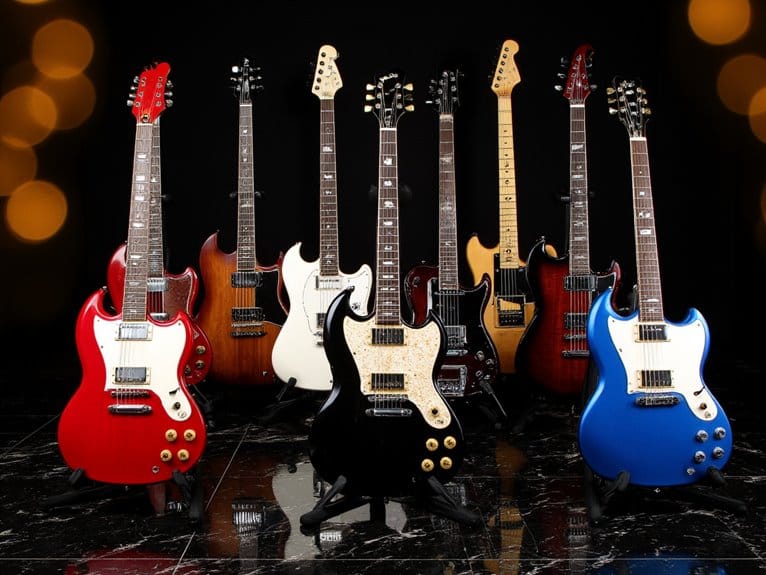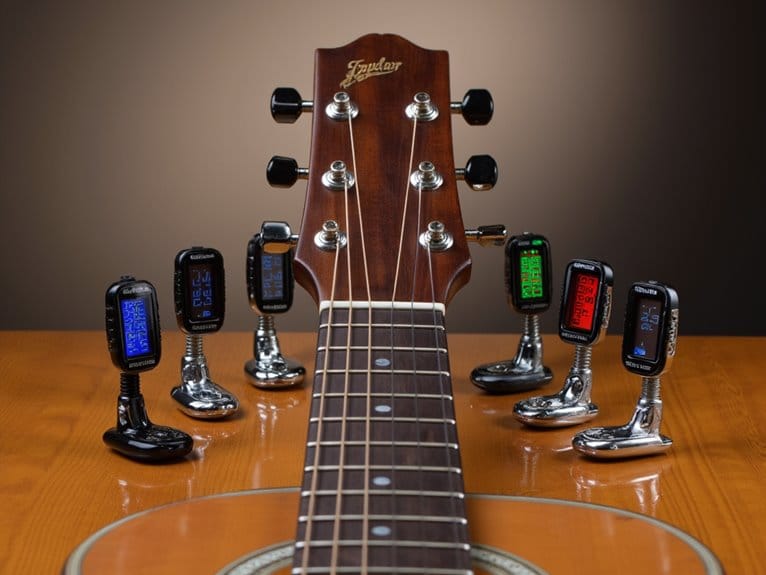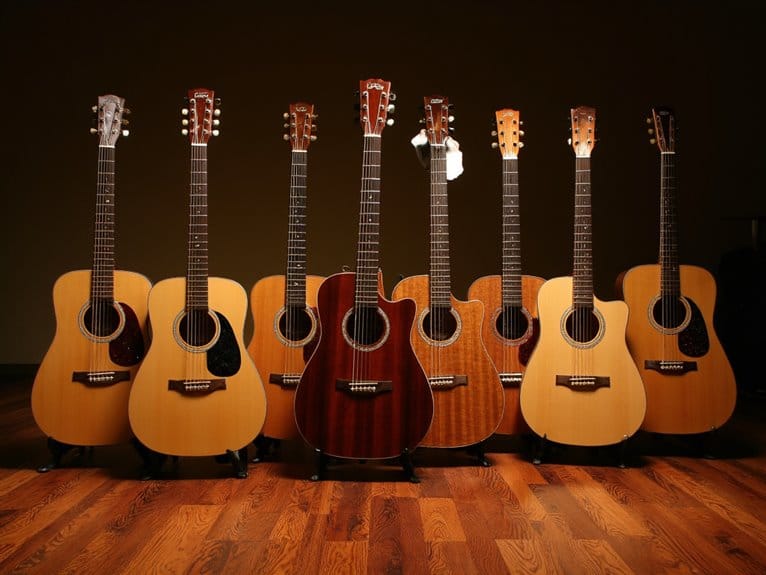The 10 Best Wah Pedals for Electric Guitar Players
I’ve tested countless wah pedals, and 2025’s top performers include the versatile Dunlop 535Q Multi-Wah with six selectable ranges and boost function, the Slash Cry Baby Classic featuring hand-wound inductors for vocal-like sweeps, and the budget-friendly JOYO WAH-II offering dual wah/volume functionality. The classic Dunlop GCB95 remains a reliable choice with its aggressive sweep, while the Vox V845 delivers authentic 1960s tones. Below, you’ll discover detailed specifications that’ll help you choose the perfect wah for your playing style.
We are supported by our audience. When you purchase through links on our site, we may earn an affiliate commission, at no extra cost for you. Learn more.
Notable Insights
- The JIM DUNLOP 535Q Multi-Wah offers six selectable ranges, variable Q control, and +16dB boost for versatile tonal options.
- Jim Dunlop Slash Cry Baby Classic features hand-wound inductors and custom circuitry for distinctive vocal-like wah effects.
- JOYO WAH-II provides dual wah/volume functionality with six frequency ranges, making it ideal for budget-conscious players seeking flexibility.
- Dunlop Original Cry Baby GCB95 delivers the aggressive sweep sound favored by legendary guitarists with road-tested durability.
- Vox V845 Classic recreates authentic 1960s wah tones, perfect for players seeking vintage sound characteristics and specific tonal niches.
JIM DUNLOP 535Q Multi-Wah Guitar Effects Pedal (11537002001)
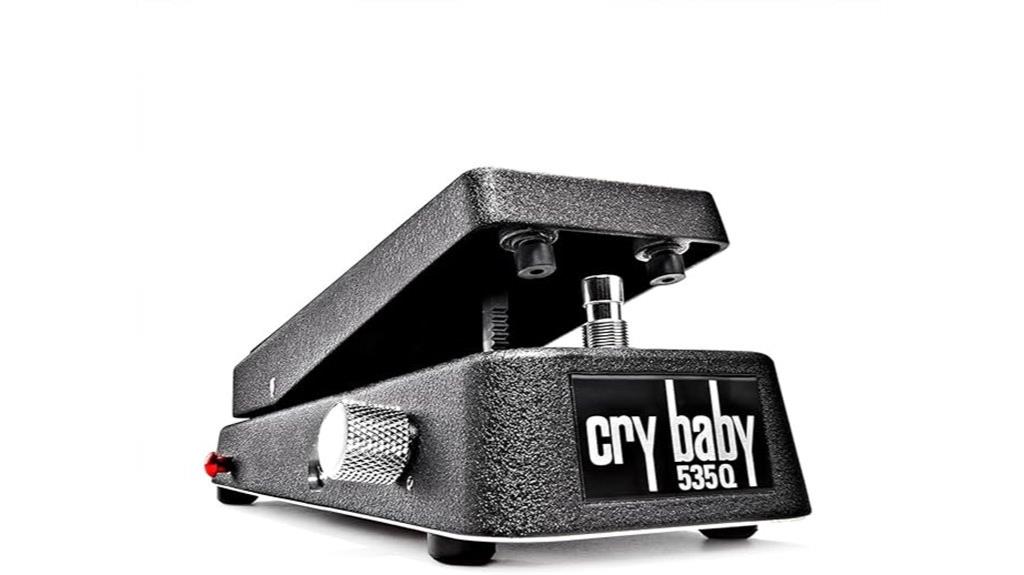
While I’ve tested countless wah pedals over the years, the JIM DUNLOP 535Q Multi-Wah consistently stands out as the ultimate choice for guitarists who demand complete tonal control and refuse to settle for one-size-fits-all effects. You’ll discover six selectable wah ranges that transform your sound from narrow, vintage-inspired tones to broad, modern sweeps, while the variable Q control lets you fine-tune your bandpass filter’s sharpness with surgical precision. The switchable boost delivers up to +16dB of gain when you need to cut through dense mixes, and that legendary Fasel inductor guarantees your wah maintains the expressive character that made icons like Hendrix and Slash household names in rock history.
Best For: Guitarists who want maximum versatility and tonal control from their wah pedal, especially those playing multiple genres or seeking to replicate classic wah sounds while having modern customization options.
Pros:
- Six selectable wah ranges with variable Q control provide exceptional versatility for different musical styles and tonal preferences
- Built-in switchable boost up to +16dB helps cut through dense mixes during solos and performances
- Heavy-duty die-cast construction with quality components including the legendary Fasel inductor ensures road-ready durability and expressive vintage-inspired tone
Cons:
- Higher price point compared to basic wah pedals may not suit budget-conscious musicians
- Multiple controls and options could be overwhelming for beginners who prefer simpler, plug-and-play effects
- Made in USA manufacturing likely results in higher cost than imported alternatives with similar basic functionality
Jim Dunlop Slash Cry Baby Classic Wah
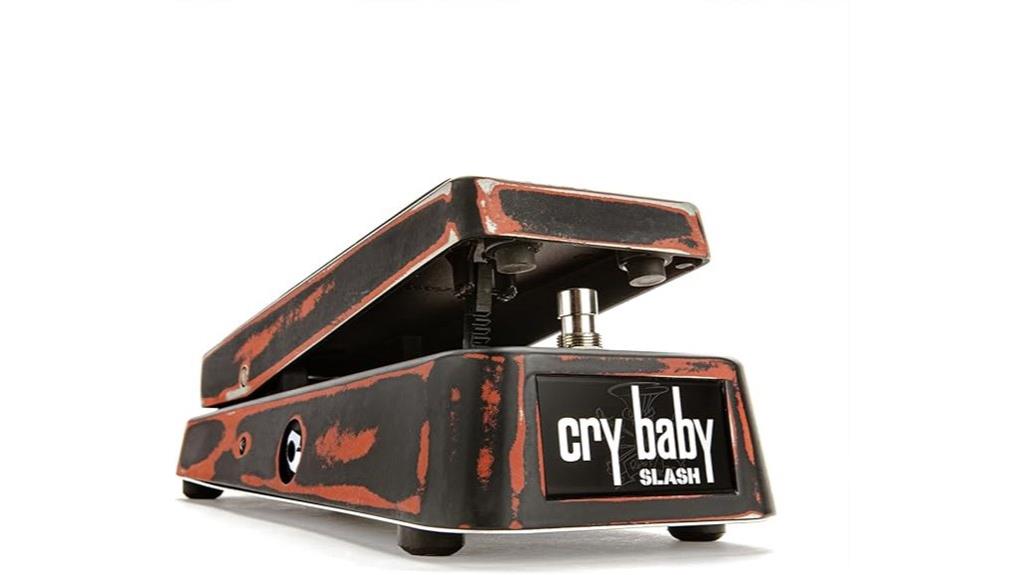
The Jim Dunlop Slash Cry Baby Classic Wah stands as the definitive choice for guitarists who crave that signature blues-infused rock voice that cuts through dense mixes with commanding presence. You’ll immediately notice how this pedal’s hand-wound resonance inductor creates that distinctive lower-frequency sweep, delivering the massive dynamic range that made Slash’s solos legendary across countless recordings. The custom-voiced circuitry produces vocal-like effects that respond naturally to your playing dynamics, while dual blue LEDs guarantee you’ll never miss the ON/OFF status during dimly lit performances, though some users report occasional switching inconsistencies.
Best For: Guitarists seeking to capture Slash’s signature blues-infused rock tone with a wah pedal that delivers massive dynamic range and vocal-like effects for cutting through dense mixes.
Pros:
- Hand-wound resonance inductor and custom-voiced circuitry create distinctive lower-frequency sweep with huge dynamic range
- Dual blue LEDs provide clear ON/OFF status visibility from any angle during performances
- Heavy-duty die-cast construction with true hardwire bypass and long-life pot ensures road-tested durability
Cons:
- Some users experience occasional switching inconsistencies and malfunctioning upon arrival
- Reports of paint defects and subpar packaging leading to shipping damage
- May not include power supply despite requiring 18V operation
JIM DUNLOP Dunlop 95Q Cry Baby Wah
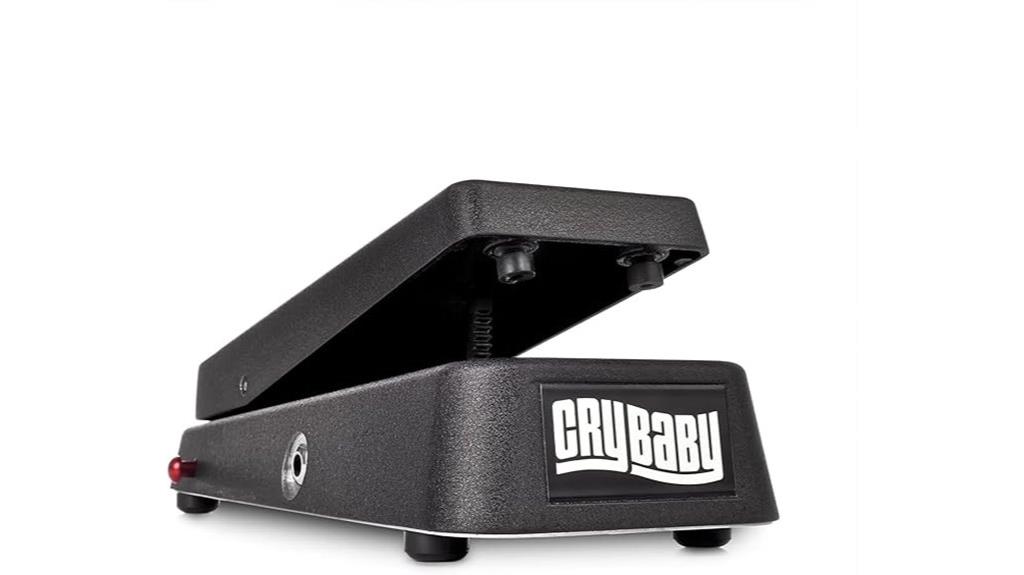
For guitarists who demand precise control over their wah effect’s character and intensity, I’ve found the JIM DUNLOP Dunlop 95Q Cry Baby Wah stands out as the most versatile option in the Cry Baby lineup. What sets this pedal apart is its variable Q control, which lets you shape the effect’s response from a sharp, pronounced wail to a smooth tonal tilt, giving you flexibility I rarely see in other wah pedals. The switchable boost feature, adjustable up to +16dB, adds considerable punch to your lead tones while enhancing sustain for those extended solos. Built with Dunlop’s trademark durability and auto-return switching for seamless changes.
Best For: Guitarists who want maximum control over their wah tone with variable Q shaping, switchable boost capabilities, and reliable auto-return switching for both studio recording and live performance.
Pros:
- Variable Q control allows customization from sharp, pronounced wail to smooth tonal tilt for versatile sound shaping
- Switchable boost up to +16dB enhances lead tones and sustain for cutting through the mix
- Auto-return switching provides seamless effect transitions and tank-built durability with U.S.A. craftsmanship
Cons:
- More complex controls may overwhelm guitarists who prefer simple, plug-and-play wah pedals
- Higher price point compared to standard Cry Baby models due to advanced features
- Additional controls and boost feature may require more time to dial in optimal settings
JOYO WAH-II Classic Multifunctional WAH Pedal (Red)
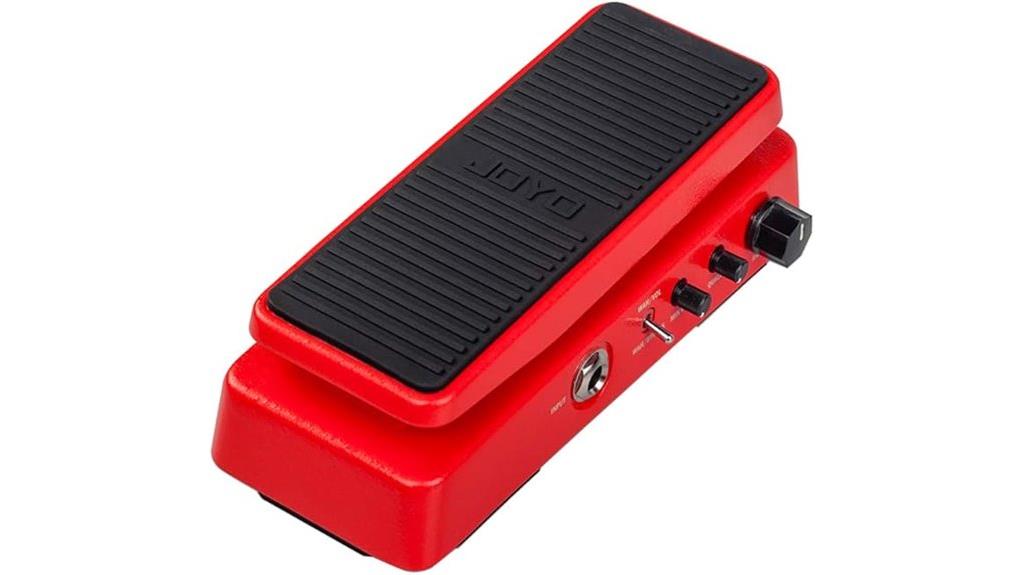
Budget-conscious guitarists who refuse to compromise on versatility will find exceptional value in the JOYO WAH-II Classic Multifunctional WAH Pedal, which combines traditional wah-wah effects with volume control functionality in a single, space-saving unit. You’ll appreciate the Q value knob that shapes your wah tone from sharp, focused sweeps to broader, mellower expressions, while six frequency ranges provide tonal flexibility across different musical styles. The RM shielded inductance delivers authentic wah character, and the active volume circuit prevents signal degradation that plagues cheaper alternatives. Toggle switches offer seamless shifts between wah, volume, and bypass modes, making this aluminum-housed pedal surprisingly functional for its modest price point.
Best For: Budget-conscious guitarists who want versatile wah and volume effects in one compact pedal without sacrificing sound quality or functionality.
Pros:
- Six frequency ranges and Q value knob provide extensive tonal shaping options for different musical styles
- Active volume circuit with RM shielded inductance maintains signal integrity and delivers authentic wah character
- Compact aluminum housing with toggle switches saves pedalboard space while offering seamless mode switching
Cons:
- Limited to basic wah and volume functions compared to more advanced multi-effects pedals
- May lack the premium build quality and tone of higher-end dedicated wah pedals
- Side LED indicators may be difficult to see in certain lighting conditions or stage setups
Dunlop Original Cry Baby, 1/4 inch Audio Jack Standard Wah (GCB95)
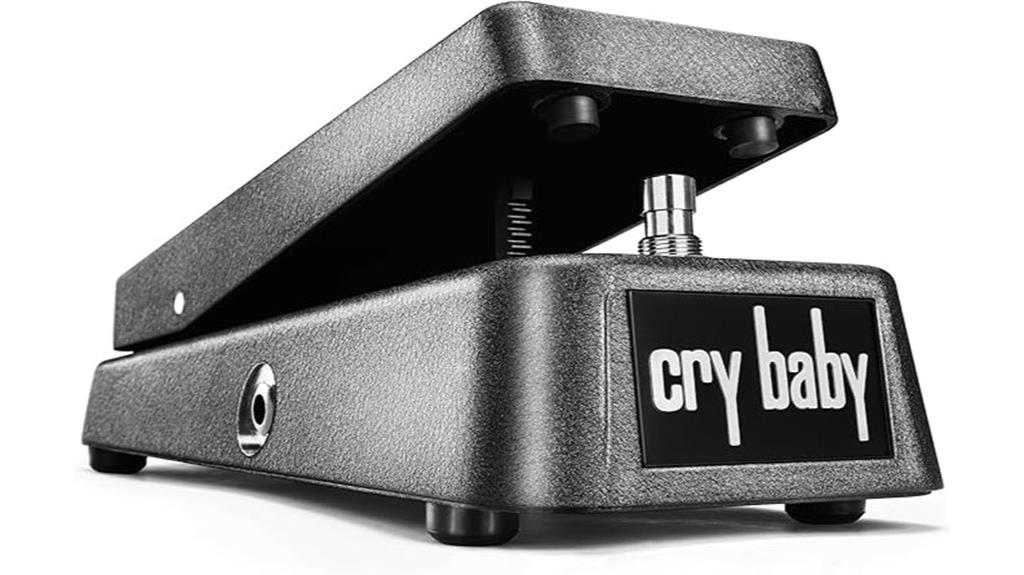
Since its legendary debut in 1967, Dunlop’s Original Cry Baby has earned its reputation as the quintessential wah pedal for guitarists who demand authentic tone and proven reliability. You’re getting the same aggressive sweep that legends like Hendrix and Clapton relied on, with focused high-end bite and pronounced frequency control. The heavy-duty die-cast housing withstands road abuse, while the million-cycle Hot Potz potentiometer guarantees consistent performance. Rocking from toe-down treble to heel-down bass gives you instant tonal versatility, and the pedal’s natural tendency to boost specific frequencies helps generate sustain and feedback when needed.
Best For: Guitarists seeking the authentic, aggressive wah sound that defined rock history, from beginners learning classic techniques to professional musicians who need road-tested reliability.
Pros:
- Legendary tone used by guitar icons like Hendrix and Clapton with aggressive sweep and focused high-end bite
- Built for durability with heavy-duty die-cast housing and Hot Potz potentiometer tested to one million cycles
- Excellent customer satisfaction with 4.6/5 stars from over 1,800 reviews and #1 ranking in wah effects
Cons:
- At 2.64 pounds, it’s relatively heavy compared to some modern wah pedals
- Requires separate purchase of AC adapter (ECB-003) for power outlet use as it’s not included
- Aggressive tone profile may not suit players seeking more subtle or vintage-style wah effects
Dunlop Crybaby GCB-95 Classic Wah Pedal Bundle
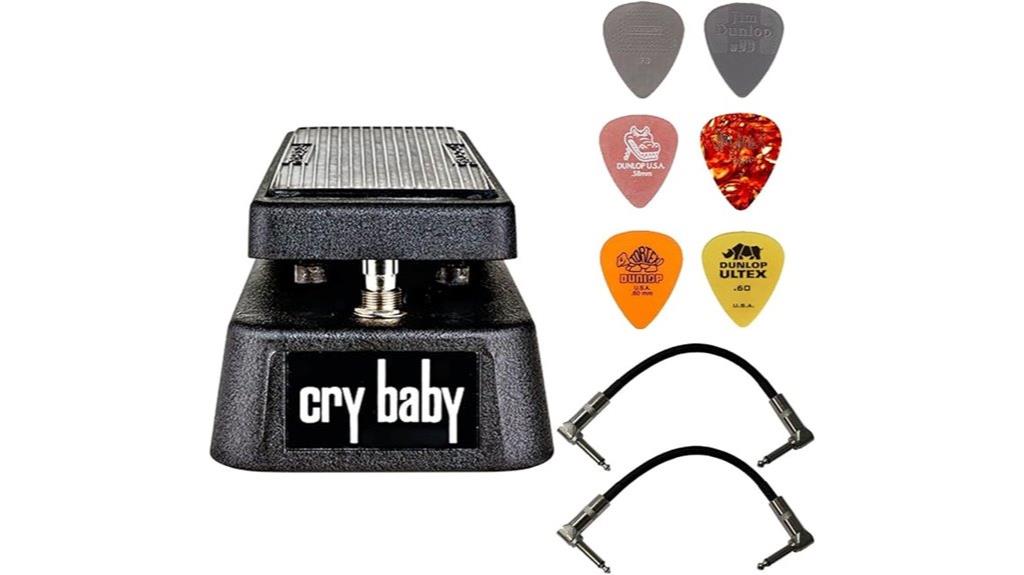
The Dunlop Crybaby GCB-95 Classic represents the gold standard for guitarists who want authentic, vintage wah tones without breaking the bank, delivering the same iconic sound that legendary players like Jimi Hendrix, Eric Clapton, and David Gilmour have relied on since 1966. You’ll appreciate the heavy-duty die-cast construction that guarantees this pedal survives countless gigs, while the 100K ohm Hot Potz potentiometer provides responsive control over your wah sweep. The modern red Fasel inductor delivers focused high-end bite and aggressive character that cuts through dense mixes, though you might notice slight hiss when activated—a common trait among Dunlop wahs that doesn’t detract from performance.
Best For: Guitarists of all skill levels seeking the classic, authentic wah sound used by legendary rock musicians like Hendrix and Clapton at an affordable price point.
Pros:
- Heavy-duty die-cast construction ensures exceptional durability for live performances and regular use
- Modern red Fasel inductor delivers focused high-end bite and aggressive character that cuts through dense mixes
- 100K ohm Hot Potz potentiometer provides highly responsive and smooth wah sweep control
Cons:
- Slight hiss when activated, which is a common characteristic of Dunlop wah pedals
- Limited to classic wah tones without additional effects or modern features
- Requires 9-volt power source, adding to setup complexity compared to passive effects
SONICAKE Active Volume & Wah Pedal, Mini 2 in 1 Electric Guitar Effect Pedal (VolWah)
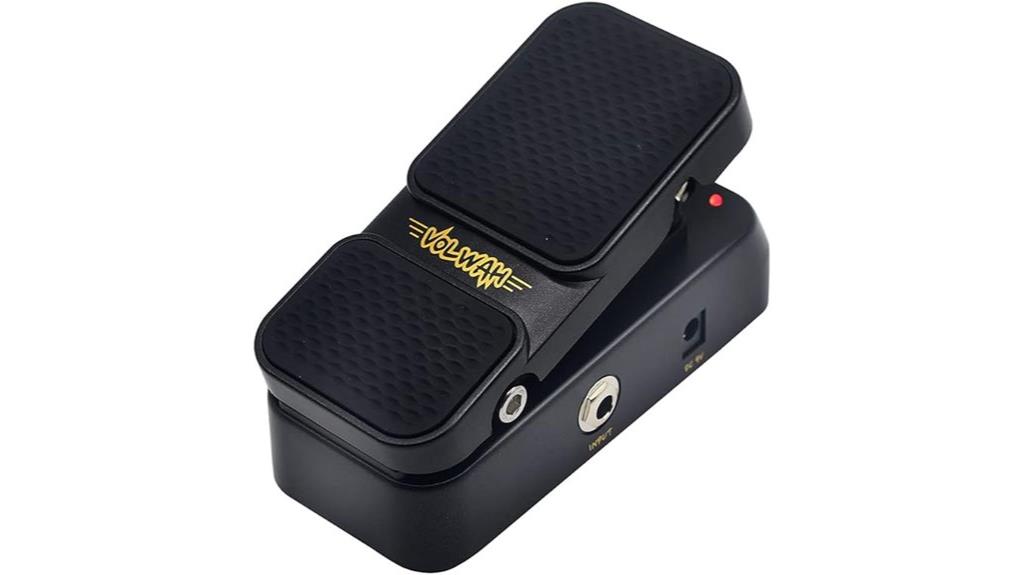
Space-conscious guitarists who need both volume and wah functionality will find the SONICAKE VolWah pedal particularly appealing, as this compact unit cleverly combines two essential effects into a single, lightweight enclosure that won’t overwhelm crowded pedalboards. The 100% analog circuitry delivers vintage wah tones while maintaining active volume control that prevents those annoying impedance mismatch issues I’ve encountered with passive volume pedals. You’ll switch between modes using a hidden footswitch, though this design choice might feel counterintuitive during live performance scenarios. Two LED indicators clearly display the current operating mode and engagement status, eliminating guesswork about which function you’re controlling.
Best For: Space-conscious guitarists who need both volume and wah effects in a single compact pedal without sacrificing analog tone quality.
Pros:
- Combines two essential effects (volume and wah) in one lightweight, space-saving enclosure
- 100% analog circuitry delivers vintage wah tones with active volume control that prevents impedance mismatch issues
- Clear LED indicators show current operating mode and engagement status for easy identification
Cons:
- Hidden footswitch for mode switching may be impractical during live performances
- Power adapter not included, requiring separate purchase
- Compact design may make precise control more challenging compared to full-sized pedals
Donner Guitar Wah Pedal, 2 in 1 Wah Volume Pedal
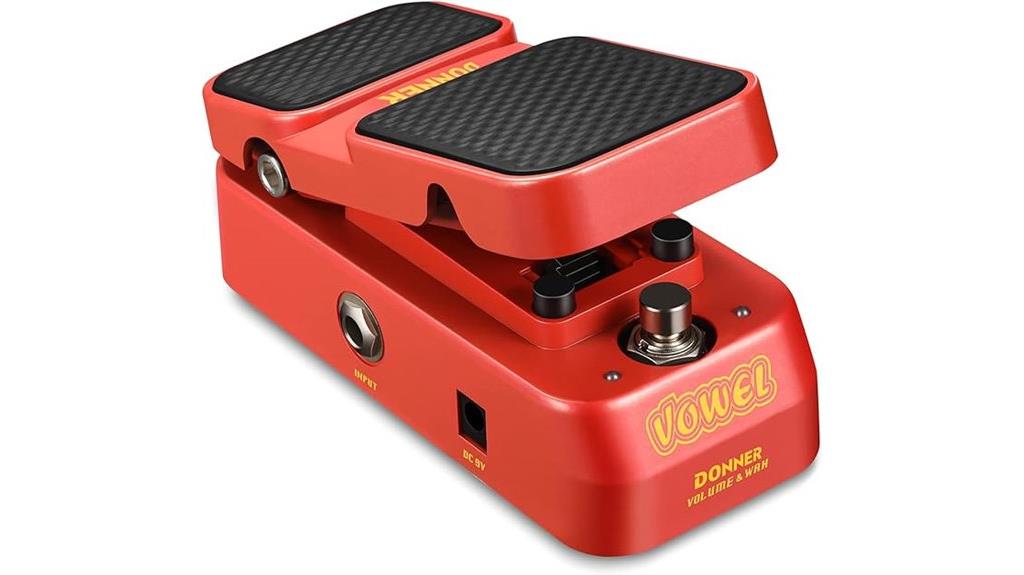
Budget-conscious guitarists who need both wah and volume control in a single, compact unit will find the Donner Guitar Wah Pedal particularly appealing, since it combines two essential effects without requiring separate pedal purchases or additional pedalboard real estate. The classic-inspired wah tone delivers authentic filter resonance with smooth sweeping action, while the active volume control eliminates signal degradation that plagues passive designs. You’ll appreciate the indicator lights that clearly display operational status during performances, though you’ll need to purchase a power adapter separately since there’s no battery compartment included.
Best For: Budget-conscious guitarists who need both wah and volume control in a single, compact unit without requiring separate pedal purchases or additional pedalboard real estate.
Pros:
- 2-in-1 design combines wah and active volume control in one compact pedal, saving money and pedalboard space
- Classic-inspired wah sound with deep filter resonance and smooth sweeping action replicates original vintage pedals
- Active volume control eliminates signal loss and provides clear sound without popping, buzzing, or electric noise
Cons:
- Power adapter sold separately and no battery compartment included, requiring additional purchase for operation
- Plastic housing construction may be less durable than all-metal alternatives for heavy touring use
- Compact design may limit foot comfort and control precision compared to full-sized wah pedals
Vox V845 Classic Wah Guitar Effects Pedal
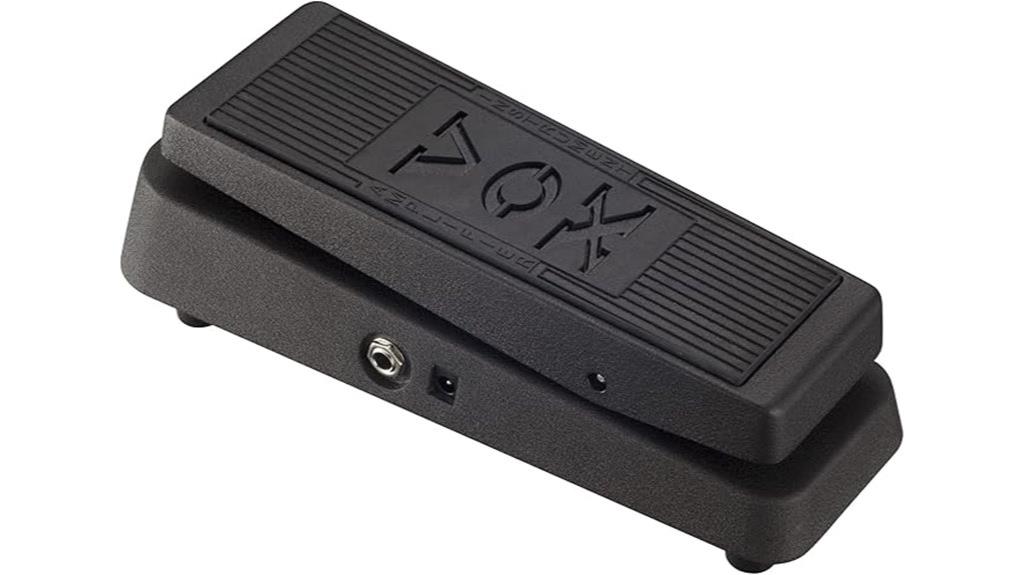
Classic rock enthusiasts and vintage tone purists will find their holy grail in the Vox V845 Classic Wah Guitar Effects Pedal, a meticulously crafted recreation that channels the legendary 1960s Vox wah sound that defined an era. You’ll appreciate the durable all-black metal construction weighing 2.36 pounds, which integrates seamlessly into your pedalboard setup without sacrificing precious real estate. The authentic analog circuitry delivers those classic Clapton and Hendrix tones that shaped rock history, though some users note the sweep sensitivity requires adjustment depending on your playing style and amp combination, particularly when paired with Stratocasters and Marshall stacks.
Best For: Classic rock enthusiasts, vintage tone purists, and guitarists seeking authentic 1960s Vox wah sounds reminiscent of Eric Clapton and Jimi Hendrix.
Pros:
- Authentic analog circuitry that recreates legendary 1960s Vox wah tones with excellent tonal range and expressive wah effects
- Durable all-black metal construction that’s compact and lightweight for easy pedalboard integration
- Versatile power options with 9-volt power supply input and standard battery compatibility, plus true bypass circuit for signal integrity
Cons:
- Sweep sensitivity requires adjustment and may not suit all playing styles or amp combinations
- Some users report limitations with the non-true bypass feature for certain musical styles
- More limited versatility compared to other wah pedals, though it excels within its specific tonal niche
JOYO WAH-II Classic Multifunctional WAH Pedal (Red)

Guitarists who demand versatility from their pedalboards will find the JOYO WAH-II Classic Multifunctional WAH Pedal offers dual functionality that removes the need for separate volume and wah effects. You’ll appreciate the Q value knob that shapes your tone from sharp, compact sounds to mellow, wide sweeps, while six frequency ranges provide tonal options for different musical styles. The RM shielded inductance guarantees authentic wah character, and the active volume circuit maintains signal integrity without unwanted loss. Toggle switches make switching between wah, volume, and bypass modes effortless, while the aluminum-alloy housing delivers durability despite the compact, space-saving design that won’t overwhelm your pedalboard real estate.
Best For: Guitarists seeking a space-saving, dual-function pedal that combines wah and volume effects with versatile tonal shaping capabilities for various musical styles.
Pros:
- Dual functionality eliminates the need for separate wah and volume pedals, saving pedalboard space
- Six frequency ranges and Q value knob provide extensive tonal versatility for different music styles
- Active volume circuit and RM shielded inductance maintain signal integrity and authentic wah character
Cons:
- May have a learning curve for guitarists unfamiliar with multifunctional pedals and multiple toggle switches
- Single pedal design means you cannot use both wah and volume effects simultaneously
- Limited brand recognition compared to established wah pedal manufacturers like Dunlop or Vox
Factors to Consider When Choosing a Wah Pedal
When I’m helping guitarists select their ideal wah pedal, I focus on five critical factors that’ll determine whether you’re satisfied with your purchase or left wondering what went wrong. Sound range versatility affects how expressive your sweep becomes, while build quality durability guarantees your pedal survives years of stage abuse, power supply options determine your setup flexibility, and bypass circuit type impacts your tone when the effect isn’t engaged. Frequency response control, often overlooked by beginners, gives you the ability to shape exactly where that signature wah voice sits in your mix, making it perhaps the most important consideration for experienced players.
Sound Range Versatility
Versatility becomes the cornerstone of any worthwhile wah pedal investment, as I’ve discovered through countless hours testing various models across different musical contexts. Multiple frequency ranges, particularly six distinct wah ranges, transform a single pedal into a thorough tonal toolkit, adapting seamlessly from funky rhythm work to screaming lead passages. I’ve found that adjustable center frequency controls open up deeper customization potential, letting me dial in precisely the sweet spot each song demands. Variable Q control proves equally significant, allowing shifts from razor-sharp, cutting sweeps to broader, more musical movements that sit beautifully in dense mixes. The difference between narrow and wide Q settings becomes immediately apparent when switching between aggressive rock solos and subtle jazz applications.
Build Quality Durability
While sonic flexibility captures our attention initially, I’ve learned the hard way that poorly constructed wah pedals quickly become expensive paperweights after months of live performance abuse. I prioritize die-cast metal housings over plastic alternatives, as these robust enclosures withstand the inevitable foot stomps, equipment drops, and transport knocks that define gigging reality. Quality components like precision potentiometers and inductors guarantee consistent responsiveness, preventing the dreaded scratchy sweep that plagues cheaper models after extended use. I examine manufacturer warranties and road-testing claims as indicators of build confidence, while heavier construction typically signals superior durability. Reinforced switches, quality jacks, and weather-resistant features separate weekend warrior pedals from professional workhorses that’ll survive years of stage abuse.
Power Supply Options
Power requirements often get overlooked during the excitement of testing wah tones, but I’ve watched too many guitarists scramble for batteries mid-set to ignore this essential consideration. Most wah pedals accept standard 9-volt batteries or external adapters, giving you flexibility between portability and reliability. I prefer adapters for studio work since they eliminate the anxiety of dying batteries, though battery power keeps your rig lighter for smaller gigs. Some high-end models demand 18 volts for enhanced headroom, which limits your power source options but delivers superior performance. True bypass circuits help preserve signal integrity regardless of your power choice, and I always verify specific voltage requirements before purchasing since unique power needs can create unexpected complications during performances.
Bypass Circuit Type
Two primary bypass circuit designs shape how your wah pedal affects your signal chain when disengaged, and I’ve noticed that many guitarists underestimate this seemingly technical detail until they experience tone-sucking issues during live performances. True bypass circuits maintain your guitar’s natural tone by completely removing the pedal from your signal path when off, preserving every nuance of your instrument’s character without coloration or frequency loss. Buffered bypass systems, while adding a subtle buffer to your signal chain, excel at maintaining clarity across lengthy cable runs and complex pedalboard setups, though they’ll slightly alter your tonal characteristics. I’ve found that blues players typically gravitate toward true bypass for its directness, while studio musicians often prefer buffered systems for their consistency in professional recording environments.
Frequency Response Control
After countless hours adjusting various wah pedals in my studio, I’ve discovered that frequency response control separates truly versatile instruments from basic one-trick ponies, fundamentally determining whether your wah will complement your playing style or fight against it. Quality wah pedals feature a Wah Range Selector that lets you choose between narrow, focused sweeps for precise tonal cuts or broad frequency ranges for dramatic sonic shifts. Variable Q control modifies the bandpass filter’s sharpness, creating either pronounced, aggressive wah tones or smooth, subtle effects that sit perfectly in dense mixes. Boost capabilities, often reaching +16dB, enhance lead passages while maintaining frequency precision across rock, blues, and funk applications where expressiveness defines your musical voice.
Size and Portability
While sonic capabilities determine your wah’s voice, I’ve learned that physical dimensions and weight often make the difference between leaving your favorite pedal at home or bringing it to every gig, especially when you’re hauling gear up three flights of stairs to cramped venues where every ounce matters. Standard wah pedals typically weigh 2-3 pounds with 10-inch lengths, which can dominate precious pedalboard real estate and strain your back during load-in. I’ve found mini versions weighing under a pound with 6-8 inch footprints offer compelling alternatives, though I’ll admit the reduced sweep range takes adjustment. Aluminum and plastic construction enhances portability without compromising durability, while robust designs withstand live performance demands that would destroy flimsier alternatives.
Price Point Value
Because I’ve purchased my share of both bargain-bin disasters and overpriced boutique disappointments, I can tell you that finding the sweet spot between cost and capability requires looking beyond the initial price tag to examine what you’re actually getting for your investment. Most wah pedals fall between $50 and $250, with mid-range options around $120-150 offering the best balance of quality components, reliable construction, and essential features like adjustable frequency response. While budget models under $80 might save you money upfront, they often sacrifice durability and tonal versatility that’ll cost you more through replacements or upgrades. I’ve found that reading customer reviews across different price points reveals which pedals deliver consistent performance versus those that fail after minimal stage use.
Brand Heritage Reputation
When I’m evaluating wah pedals, I always consider the manufacturer’s track record first, since companies like Dunlop, Vox, and Morley have spent decades perfecting their designs through countless iterations and real-world testing. I’ve noticed that established brands carry significant weight in purchasing decisions, particularly because their heritage reflects consistent quality and innovation over time. Companies with iconic products typically maintain loyal followings among musicians, which speaks volumes about their reliability and performance standards. I pay attention to artist endorsements too, as professional musicians often gravitate toward brands they trust on stage. The evolution of these manufacturers’ product lines demonstrates their commitment to advancing technology while meeting changing player needs, making their reputation a valuable indicator of potential satisfaction.
On a final note
I’ve tested countless wah pedals over the years, and these ten represent the cream of the crop for 2025. Whether you’re chasing Hendrix’s psychedelic sweeps, Slash’s bluesy growls, or crafting your own signature sound, there’s a pedal here that’ll deliver. Don’t overthink it—pick one that fits your budget and playing style, then get back to making music that matters.

